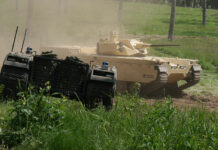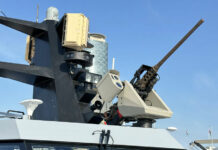By seizing the so-called “Philadelphi” route along the Gaza- Egyptian international borderline, Hamas has finally taken full control of all exits and border crossings into the Gaza Strip- where they are about to create an Islamic Fundamentalist Hamastan.
Israel is highly concerned from the flow of Iranian originating weapons and munitions into Gaza through the underground tunnels under the Philadelphi line that was abandoned by Israel two years ago. That will make Gaza the terror empire of the Middle East under Iranian-Syrian, or al Qaeda control.
Israel’s Foreign Ministry is putting together a plan to station an international force on the Philadelphi route in Rafah to stop weapons smuggling from Sinai to the Gaza Strip. Israel believes that such smuggling is strengthening Hamas in Gaza, and stopping it will be the key to improving overall security in the entire region. Foreign Minister Tzipi Livni hinted at the possibility of deploying an international force in her briefing to ambassadors Friday. Mrs. Livni was asked by European Union Ambassador Ramiro Cibrian-Uzal whether Israel still objected to the idea of a UNIFIL-style foreign peacekeeping force in Gaza. Livni said in response that UNIFIL, the United Nations Interim Force in Lebanon, was a test case, and that the force’s many remaining challenges in Lebanon underscored the difficulties of such missions.
According to Dr. Dore Gold former Israel Ambassador to the United Nations, international force deployments have been extremely problematic in areas still afflicted by active combat operations. The main issue is that these forces spend most of their energies seeking to protect themselves from attacks of the more aggressive party, in particular. As a result, these forces inevitably decide to appease the party that threatens them more. For example, UNIFIL established intimate ties with Hezbollah over the years, in order to protect itself. It failed to address serious cease-fire violations and in the case of the Israeli invasion into Lebanon against the PLO in 1982, UNIFIL even stepped aside without interfering in any way. Another example should serve the prompt withdrawal of the United Nations force from Sinai in June 1967 which started the Six Day war with Egypt.
The Rafah Border Zone
Rafah is an ancient city, founded in the eighth century BC. Called originally Robhiwa by the Egyptians, Rafihu by the Assyrians, Raphia by the Greeks and Romans and finaly Rafah by the Arabs, this strategic area on the border of the Sinai peninsula was for centuries a focal point for famous military campaigns.
The first, documented on the walls of the famous Temple of Amon at Karak in southern Egypt, depicts the great battle 1314 BC which Pharao Seti I. fought against the Hittite king west of the present city, then as now the gate to Palestine in that narrow strip of land, between the Sea and impassable desert.
Many famous campaigns were fought here,over centuries, until in June 1967 the Israeli Army finally captured the Gaza Strip in what became known as the Six Day War. Currently numbering over 130,000 residents, the majority packed into several cramped refugee camps, its inhabitants making up over 70% of the population.
Rafah appeared first in an official capacity as a border town in 1906. On a map drawn by mutual agreement between Britain and Turkey, a line was drawn from Rafah southward to Taba, west of Aqaba. This boundary remained unchanged after World War I, and marked the border between the British mandatory in Palestine and Egypt. Egypt captured the Gaza strip in 1948, but did not annex it officially until 1967. Following the peace agreement with Egypt of 1979, Israel returned the whole of Sinai to Egypt, withdrawing to the original border delineated in 1906. The Gaza Strip, however, remained under Israeli military rule. However, Rafah, once again a border town and was soon to become the focus of attention again, as a notorious lawless smuggling center, in which neither Israel, nor the PNA, could exert its authority.
Rafah City – The Gateway to Terror
As a border town, Rafah always had enjoyed its unique location as one of the most flourishing smuggling centers in the Middle East. The ancient trade routes ran for centuries through its coastal strip, from North Africa to Mesopotamia. Following the 1979 treaty, Rafah city was divided between Israel and Egyptian territory, straddling the border. There were now two Rafahs instead of one. Egypt having refused Israel’s proposal to incorporate Rafah into its territory in Sinai, insisting on the 1906 boundary to the last letter.
With IDF stationed thinly along the, now peaceful border and Egypt under the constraints of its 1979 Peace Treaty restricted to deploy only lightly armed civil police in what was named Zone C ( the area between the international border from Rafah to Taba), the divided town, with its close family ties on each side, became ideal for lucrative smuggling activities.
The “Philadelphi” Route Story
According to the 1994 signed Gaza-Jericho Agreement, a so-called “Pink Line” was demarcated along the Egyptian Sinai border to become the ” Military Installation Area” under full control of Israel, acting as buffer zone to prevent unauthorized infiltration. This area, clearly marked on Map No.1 in the attached agreement, was signed by all partners and came into effect immediately following the Israeli withdrawal from Gaza. It received its official Philadelphi designation from the original IDF military random code map, in which this route was displayed.
Unfortunately, due almost criminal shortsightedness by the Israeli negotiators, ignoring professional military caution, the “Pink Line” was demarcated, stretching 8500 meters from south-west to north-east hugging the Egypt-Israel international border, but with only a mere 60-100 meter wide stretch under Israeli sovereign territory. Such a ridiculously narrow area, left to IDF control, represented a military nightmare ever since, rendering an effective defence, or transborder surveillance virtually “mission impossible”.
This strip, which, at the time was considered by the negotiators to be maintained only by lightly equipped border guards, was never expected to become a warfighting zone. But the Oslo planners soon proved terribly wrong in their unrealistic estimates. Only a few years later, Rafah became one of the most dangerous places in the Middle East. Matters got much worse, since Sharon’s intentions to withdraw from Gaza.
Currently achieving strategic proportions, mainly through Hezbollah, wishing to saturate the Rafah Strip with advanced weaponry, it turned into a major war zone- with the IDF trapped into this indefensible narrow strip, struggling desperately to block the dangerous gunrunning traffic going on underneath.
The Rafah Tunnels – Intifada’s Lifeline
To ease drug traffic and other illegal commodities, the Palestinians constructed a complex network of subterranean tunnels under the Egypt-Israel border and the IDF controlled Philadelphi strip. A virtual subterranean tunnel city has been constructed underneath the Egyptian border line.
For several years these tunnels served local smugglers for illicit transit of cigarettes, drugs, and even prostitutes, from Egypt to Gaza. But following the 1993 Oslo Accords Rafah became a major transit point for illegal weapons smuggling into the newly established Palestine National Authority (PNA) in Gaza. The ‘traditional’ smuggling activities were quickly seized upon by Palestinian terrorist organisations, who utilised them to transfer much needed weapons and explosives for the Intifada. For decades the traditional Bedouin tribal families, like the Abu Samhadanahs, Al-Dhair, and Abu Rish, have held the city keys firmly in their hands.
An interesting glimpse into the running of the Rafah tunneling system was revealed a few years ago, through the interrogation of a Palestinian ‘tunnel expert’ by the Israeli intelligence and analysed later by a Haifa Technion researcher:
“The tunnel is constructed like an artery system, with several access passages branching off like veins to various basements in the Rafah residential buidlings on both sides of the border”, the researcher said.” Shut off one passage and there will be plenty left for immediate further use”. Another riddle which haunted IDF counter-tunnel experts was the varying ground water levels in the Rafah region.
Originally Israeli geologists estimated the water level to be 12 meters. However it turned out that the Rafah tunneling experts were already digging tunnels at 20 and even 30 meters depth. The Reason for this discrepancy seems to be the rapidly changing coastal aquifer, which due to excessive pumping causes a constant decline of the ground water level in the Rafah region. Various mechanical devices are used to overcome natural obstacles, like rock. Recently special earth suction machines were imported to remove sand. The work is conducted under total secrecy. Sand is removed in periodical shifts using flour bags and transported by truck to remote locations. Lookouts are posted at each entrance to warn of any Israeli, or Egyptian patrols. Workers involved in tunnel construction receive percentage of the profit generated.
The standard rate is between six to twelve meters dug per day. At either end of the system is a work manager, using landline phone contact, by coded messages, to evade IDF listening post interception. Exit on the Rafah side is through vertical shaft, which can easily be camouflaged, or temporily sealed off.
Once the tunnel is ready to receive shipment transfers, an established routine is being followed:
- The shipment is requested on the Egyptian entrance by the ‘work manager’ in charge, who gives details of the shipment via password and code by phone.
- Light transports are ferried by cable, heavier equipment is transferred on trolleys.
- Highly specialised shipments and VIPs are conducted through larger tunnel systems, which have walled paneling, electric lighting, air shafts, rails and even mechanical transportation systems available.
But Rafah tunneling is also a highly dangerous business and not only from IDF intervention. A major risk involves suffocation and drowning. Longer tunnels require special breathing ducts, which are natural give-aways to the IDF patrols. Following several disasters, Rafah tunnel constructors acquired special breathing apparatus, which are now used. The danger from drowning is even more hazardous, due to the sandy nature of the coastal ground, which often causes tunnels to collapse with water flooding. A few months ago a group of Palestinians were saved from drowning in their tunnel by an IDF rescue squad called onto the scene by locals.
Much now depends on the future conduct of the Egyptian authorities in Sinai. Sofar they have done little to stop the smuggling route, either overland or underground. An Israeli intelligence official has mentioned, that Egyptian Intelligence possesses the names list of all involved in illegal traffic over the Sinai desert and, when ready, can crack down on this dangerous smuggling racket within days, once it decides to do so. So the decision to avert a catastrophic Hamastan in the Gaza Strip is now entirely in the hands of the Egyptian authorities, who are the undisputed sovereigns in the Sinai Peninsular. Only they can effectively seal off this dangerous traffic zone.
For earlier analysis on the situation in Gaza please check:
- Post Arafat: Two Palestinian Entities
- Inner strife splits Gaza from West Bank
- Hamastan Gaza- to become a Wahhabist Outpost?
- Military Confrontation with Hamas in Gaza Unavoidable
- Al Qaeda spurs Gaza carnage to create Hamastan
- Gaza – Hamastan to be Declared Rogue State
- Shattered cease-fire sends Gaza spiraling into Civil War
Also from David Eshel – 1967 Six Days War Retrospect:
How the Kremlin Manipulated the 1967 War to the Brink of Nuclear Conflict
















